Have you ever heard of Gary Vaynerchuk?
If not, it’s okay. He just loves telling people to make money online by going to thrift stores, garage sales and finding products around your house to sell.
It’s incredible how people are making an extra $500 per month this way!
But where do you sell the products you find?
Well…online marketplaces are meant for second-hand products. So that’s a great place to start.
It’s a fun way to make quick money – but the problem is, you might not know what a “marketplace” is or where you can find them.
Let’s get started:
Table of Contents
What is an Online Marketplace?
An online marketplace is an app or website that allows buy and sell second-hand products.
You can sell things like an old couch or that bike you never use. And you don’t have to go to your local thrift store anymore because you have access to way more things on these platforms.
These marketplaces act as a facilitator for sellers — this allows sellers to make money on these marketplaces by reaching a larger audience.
Just think of eBay and Amazon – they’re the ultimate examples of online marketplaces.
Now, let’s go a little more in-depth on what marketplaces are, then dive into where you can find the biggest, smallest, and best ones. Then, we’ll discuss how to get started selling on one.
Why Use an Online Marketplace?
Online marketplaces facilitate shopping for everyone. You can now easily declutter your home or make some extra cash to pay a couple of bills. This works well everyone for a couple of reasons.
Number 1: People don’t like paying for new things all the time. Especially if they’re buying something for a guest room or for their kid’s room. Thrift marketplaces allow people to get a great deal on good products.
Number 2: Sellers want to declutter their homes, make some extra income and more importantly not pay any fees. Making some extra cash on thrift marketplaces is a cheaper alternative than starting an online business that comes with its own costs.
But marketplaces have some downsides, too.
Downsides of Online Marketplaces
For buyers: The information on products and the sellers are poor, and delivery speeds tend to vary. Making a marketplace work means drawing from many suppliers simultaneously and making it seamless for the consumers – which is tough to do.
And for sellers, your biggest drawback of using a marketplace is that customers might be unreliable. They might tell you they want to buy something but never show up at your meeting place.
There are 4 main types of online marketplaces. Let’s break ‘em down:
- Vertical: Vertical marketplaces sell products from many sources – but they’re all the same type. For example: Depop.com sells only clothing.
- Horizontal: These marketplaces are the opposite – they sell many different types of product, but they all share a similar characteristic. Example: Decluttr is exclusively electronics.
- Global: These are the ones we think of first – places like eBay. They sell everything.
- Hybrid: These combine the characteristics of the main 3 categories together. Walmart is one of these, and so is Amazon. Both allow their users to list their own products alongside the website’s own.
Now we can move onto the next part of this guide:
What are the different marketplaces?
The Biggest Online Marketplaces – Amazon and eBay
While these biggest eCommerce sites aren’t technically “thrift”-specific marketplaces, they’re so big – billions in yearly revenue – that they bear mentioning. Given their immensity, these are where you should spend the bulk of your time selling once you’re established, as each has such a huge audience to take advantage of.
We’ll break down each into the pros and cons with some commentary on their application to flipping.
1. Amazon
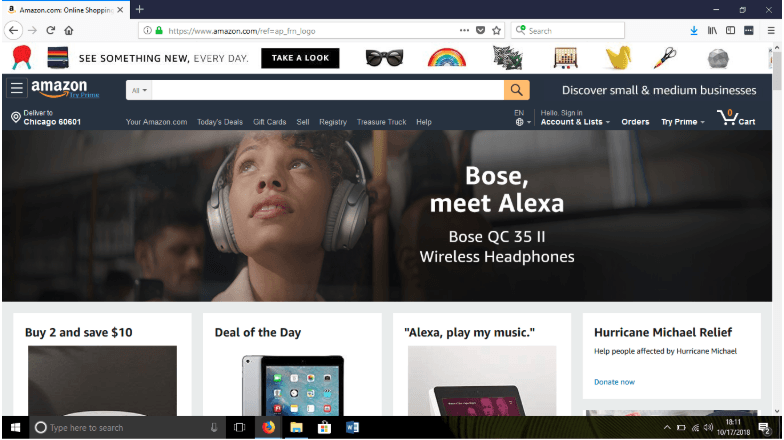
Pros:
- Size and credibility — The largest online retailer, with over 350 million active members. They’re big, they’re established—new customers are comfortable purchasing from them because they know them. Amazon has one of the highest satisfaction ratings from both new and repeat buyers.
- Great seller infrastructure — Amazon has everything figured out for sellers on the back-end. From inventory tracking and tax collection to credit card processing – it’s all possible here, so you don’t need to figure out how to set it all up yourself.
- Fulfillment service — Amazon also has their Fulfilment By Amazon (FBA) service, which allows sellers to ship inventory to Amazon warehouses. Then from there, Amazon handles the sales, fulfillment, returns, and customer service.
Cons:
- Fees – Amazon breaks down sellers into two categories: Individuals who sell fewer than 40 items per month and Professionals selling greater than 40 items per month. For Individuals, you’ll pay a dollar fee per item as well as separate category fees. Professionals pay in monthly subscription ($40) and category fees. FBA also increases your listing fee and you lose money to fulfillment fees on items. So the more you sell, the more you pay.
- Commoditizing – Not specific to Amazon alone, but somewhat unique: not only are you competing against other sellers of similar products, but you’re also competing directly against Amazon if they also sell your product.
- Poor customer loyalty – Customers buy from you, but they go through Amazon. They’re loyal to Amazon, not you, so getting repeat-customers is difficult.
Note About Amazon
Best way to start with little money: You can sell just about anything on Amazon, but with no money, it’s best for used electronics. Their trade-in program makes it easy for anyone to sell used electronics. Amazon gives a set price for anything you find at thrift stores, garage sales, or from other sources. They give you a shipping label and you get paid.
Recommended: Starting an Amazon FBA Business
2. eBay
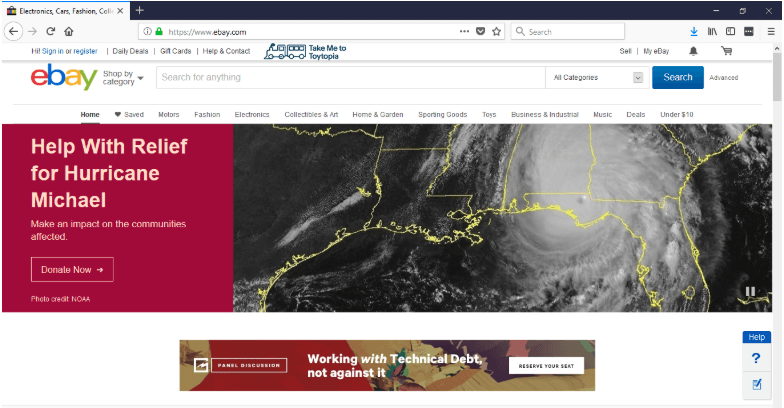
Pros:
- Size and ability to sell anything — eBay has more than 200+ million active buyers globally. Everyone knows it and it’s well-established as a place individuals can go to sell both new and used items. Their auction format helps you list just about anything with millions of people looking.
- Global shipping program – It’s easy to ship anywhere in the world by letting you ship your item to a U.S.-based “hub” that then takes care of international shipping.
- Easy-to-use – Their selling, listing, and inventory tools make it easy to sell quickly. Many features are now free, as well.
- PayPal – With PayPal the most preferred payment method of many sites and consumers. Since PayPal started out under eBay’s umbrella until 2015, they have a tight integration.
Cons:
- Fees – eBay seller fees can add up quickly. You’ll typically pay 10% of the sale price, with a max fee of $250; but advanced listing upgrade fees are higher, and PayPal takes another 3%. This eats heavily into profit, especially on already-small-margin items.
- Favors buyers over sellers – eBay has made it increasingly difficult as years have passed that have tipped the scales toward buyers. More recently, sellers have been hurt a 180-day return policy hurts and the inability to leave negative feedback against buyers.
Note About eBay
eBay is the biggest marketplace that you’ll find well-seated in the flipping world. But, rare, one-of-a-kind or vintage items – think old comic books, books, stamps, coins, antiques, and the like – sell especially well, for especially high prices.
As well, anything with high margins – i.e. things from dollar and thrift stores, as well as garage and estate sales. Finally, anything you can’t sell anywhere else – like random boxes, remotes, power cords, and old software.
These global online marketplaces are great ones to start with, as you can flip a wide range of items quickly. But, when you’re flipping items, you need thrift-specific marketplaces. That’s the focus of our next section.
The Best eBay Alternative Platforms
While you may not have thought of these as “online marketplaces,” per se, each of the following meets the definition we laid out above. And what’s more, unlike the giant Amazon and eBay, these marketplaces are geared for buying and selling locally – which makes them great places to get started, and can save you on shipping costs, too.
Many of these marketplaces share similar pros and cons, so we’ll address each the first time they arise, then focus on the variances between the platforms from there out.
3. Craigslist
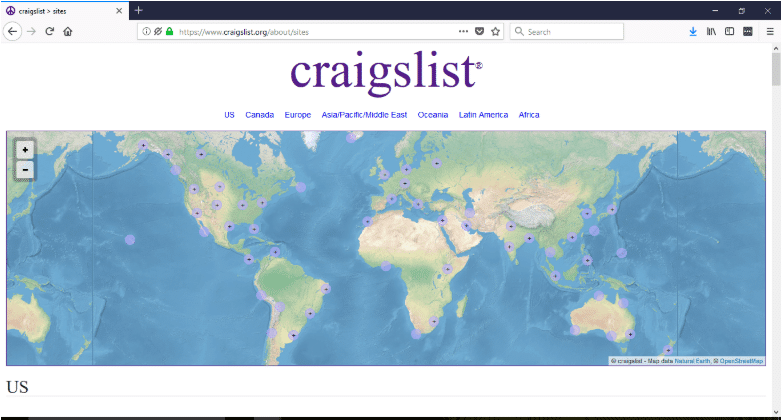
Pros:
- Simple and easy-to-use – Craigslist has refused to alter its simple format, which makes listing items incredibly easy. You don’t have to invest much time, which makes it ideal for side cash or a hobby, but with the added benefit of being able to turn it into a full-time thing.
- Zero fees – Unless you’re attracting customers from greater distances, you don’t have to pay for shipping. Neither do you have to pay to create the listing, and there are “free” sections, where you can find items to pick up and flip for profit.
- Local – If you live in a city or metropolitan area, you’ll have an almost endless supply of free and cheap items to flip.
Cons:
- Local – If you live away from cities or metropolitan areas, you’ll have to travel to pick things up. For larger items, you may need to invest in a pickup truck – an additional cost up front.
Scammers and safety – Marked as a “classifieds,” you’ll face scammers, so it’s important to pay attention and watch for indications when viewing and responding to listings. And, since transactions typically take place in person, you’ll have to be careful about where you agree to meet.
4. LetGo
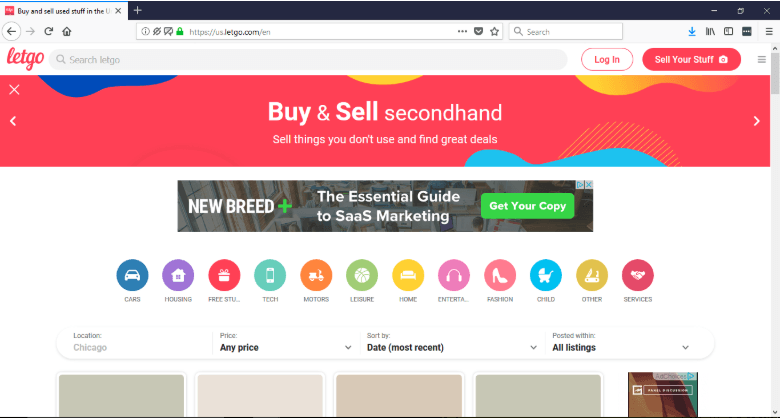
Pros:
- App– LetGo has an app, making it easy to list and respond on the go.
- Product-only listing– Unlike Craigslist, LetGo offers items exclusively. It also makes listing products easier: a feature allows you to take a photo of your product, then builds the listing according to the category it belongs to. With it labeled by the platform itself, you don’t have to worry about it landing in the wrong category. It only works with photos you take yourself, so that also assures buyers that it’s a legitimate item.
- Buyer-seller chat– Once a buyer expresses interest in an item you listed, LetGo sets up a chat, instead of giving out your personal phone number or email. You can communicate and haggle with a written record attached to the conversation. But, there’s no way to pay through the app, which can prevent either buyer or seller from being scammed.
- Local
Cons:
- Still have to meet in person– Despite the advances made with the app, you still have to meet in person to make the transaction. They offer tips on doing so safely, like taking a friend with you, but there’s still risks involved.
- Ratings, Reviews, and Verification– This is both a “pro” and a “con.” First, to sell on LetGo, you need to be verified by linking your seller profile to either your email or Facebook accounts, which assures buyers that you’re a real person. That’s good. Ratings and reviews are double-edged: if you can get great reviews, no problem. Nothing to worry about. But if you get some bad reviews, it can easily hurt the reputation of your business. But, since most people rely on them, it’s also a “pro” that LetGo offers the option.
- Local
5. Facebook Marketplace
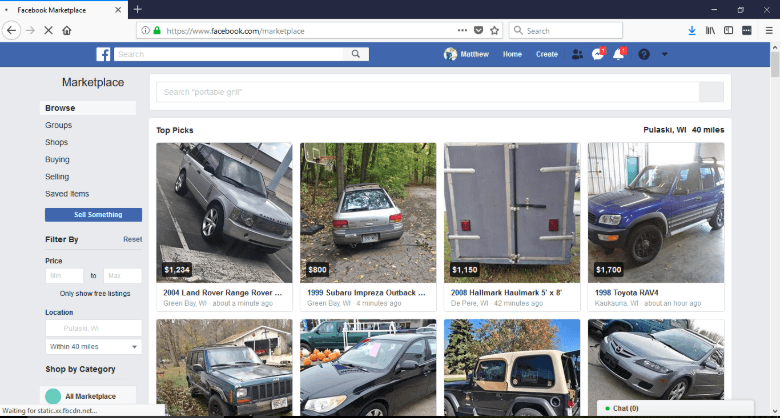
Pros:
- User accountability – Facebook Marketplace only works when you’re logged into Facebook, which adds accountability to the process. Sellers can view buyers’ profiles, and buyers can view sellers’. This can help avoid scams and unsafe situations on both sides.
- Local – Settings default to within 100 miles.
- Online payment – You can have buyers pay online via PayPal.
- Groups – “The Marketplace” allows you to join or create Facebook groups and buy/sell within it. These can be good ways to find garage sales for more flipping.
Cons:
- Potential shady practices – Facebook Marketplace allows stock photos to be used. As long as you follow some tips we’ll outline below, this shouldn’t affect you as a seller – except to make your photos stand out better. There is also no user rating system, and while you can have customers pay online through PayPal, The Marketplace has no obligation to help you get your money back if something goes wrong.
6. OfferUp
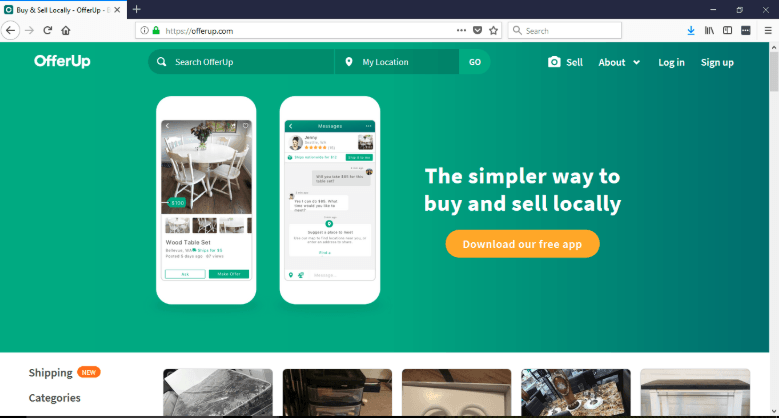
Pros:
- Size – Of mobile selling apps, OfferUp has higher traffic at about 17 million users every month – and growing.
- User-friendly app – More attractive to younger generations, helping you reach another demographic that might not use Craigslist or one of the others listed here. It’s also easy to list on OfferUp’s app – take a few pictures, type a description, and post.
- No listing fees – OfferUp doesn’t make you pay a listing fee and there are no limits on how many items you can list.
- Local and in-chat messaging
- Safe meeting spots – OfferUp has gone to lengths to locate safe meet-up spots, like police stations, for sellers and buyers to make transactions.
Cons:
- Re-posting – OfferUp filters according to product categories, prices, and distances. Because of the sheer volume of daily entries, however, your listings can easily be bumped further and further from the front page. So, you have to re-post every week – or, pay a small fee (about $2) to “bump and promote,” which makes each listing more visible for longer.
- Shipping fees – If you decide to ship through OfferUp, they’ll charge you 7.9% of your sale.
- Local and safety – As with the others, since it’s local, you’ll often meet with buyers in person. Despite in-app communication, you’re still meeting a stranger.
Small Online Marketplace Alternatives
7. Oodle
Oodle uses the technology that powers Facebook Marketplace to provide a personal experience and allow friends to recommend you as a seller. Despite this, you don’t need a Facebook account to post – but if you have one, it’ll be accessible through Oodle.
8. Geebo
Geebo has been around for some time, as well. They focus on the U.S. and have a simple, but colorful and modern design.
Niche Online Marketplaces
As a side note, if you’re interested in selling a specific type of item (remember vertical marketplaces?) – in particular, clothing or jewelry – there are certain marketplaces that focus on just those things.
9. DePop (Clothing)
10. Rebelle (High-end jewelry, Wearables with luxury labels)
11. Vinted (Clothing, Shoes, and Accessories)
12. ThredUp (Thrift and Consignment)
13. Poshmark (Fashion)
14. Decluttr (Technology)
15. USell(Phones & Tablets)
How to Get Started Making Money Using Online Marketplaces
Now that you know where to go, how do you get started? It’s very simple.
Every one of the marketplaces in this list is pretty easy to get started with. Just visit the website of your choice through one of the links here and sign up to become a seller. If they have an app, download it to your smartphone to make things even easier.
That being said, here are some general tips for making your first posting:
- Clean it up: Many postings say something like, “Small stain on the lower right corner that will clean up easily.” Why not just clean it then? Don’t tell the buyers about it, just clean it. Of course, if you can’t fix or clean it, make sure you include that in the listing.
- Take a good photo: If you’ve seen any listing – online or otherwise – you’ve seen poorly lit, poorly angled photos. Take a minute to make sure the room you’re taking the photo in is well-lit and you’re not holding your phone or camera at an odd angle. Learn from Instagram – people like light and bright photos.
- Stage the item: When you’re selling a piece of furniture, or clothing, or books – stage them. If you’re selling a dress, employ someone as your “model.” Have them pose naturally in a bright, well-lit room, from a few different angles that showcase the piece.
- Use multiple photos: When you take your photos, shoot for at least three strong ones. Use different angles and zoom in on any interesting parts. Think of this way: your buyer wants to feel like they’re looking at it in person – do the work for them.
- Add some keywords: When you make your listing, don’t just type “Size 10 dress with flowers.” Instead, type “1958 Blue Floral Dress. Excellent condition. No fading or stains.” You’ll get a lot more clicks on the second version than the first. Be descriptive. Some great keywords to use include things like, “new”, “barely used,” “new with tags,” “excellent condition.”
- Don’t Lie: If that 1958 floral dress you found isn’t in “excellent condition” – don’t lie about it. Be honest. “Fair condition” is just fine. Always take photos of what your item actually looks like. Sure, it’s going to scare some people away, but better then, than when they get to your meeting place and find out you lied.
- List items separately: If they’re a matching set – that’s fine. If they’re five unrelated items – don’t. Since most marketplaces categorize, this just makes it hard to find what they actually want, and you may get lumped into another category. People search for specific items, not random collections.
- Price high, sell low: People tend to like bartering, so price higher than you’d accept so that when people talk you down, you’re at a price you’re comfortable selling at.
To Summarize a Long Post
Oof – that was a lot.
But you made it. Let’s summarize what we talked about:
- Marketplaces are websites and apps where people and businesses can post new or used items for sale and reach larger audiences more easily than on their own.
- There are many online marketplaces. eBay and Amazon are some of the biggest ones.
- Some smaller, locally-geared ones include LetGo, Facebook Marketplace, OfferUp, and Craigslist.
- You can “niche down” and sell more specific items on websites like DePop, Poshmark, and Rebelle.
- Making your first listing comes down to staging your items for well-lit photos and being descriptive and honest.
Now that you’ve read this guide, you’ve got plenty of information to digest. Once you’re done doing that, get out there and start making money online with these platforms!

Hi Mitchell,
Thanks for the wonderful information. Impressed the way you explained the scenarios.
I have few queries regarding this. When I added a small product which costs around $2 the shipping charges are ~ $45 to India. Feeling bad with the shipping charges. How can I get them reduced and, which way of login will give us best price as business person or like an individual.
I have many questions like this. Could you please advise me.
Your response will be appreciated.
Thanks so much.
Regards,
Suresh
Hey Suresh, thanks for reaching out I would love to help you out with this. Where are you buying products from and what is the amount of products you’re trying to buy?